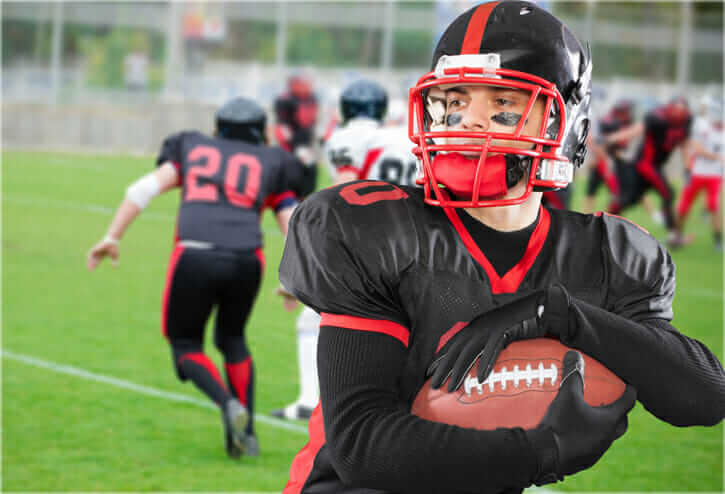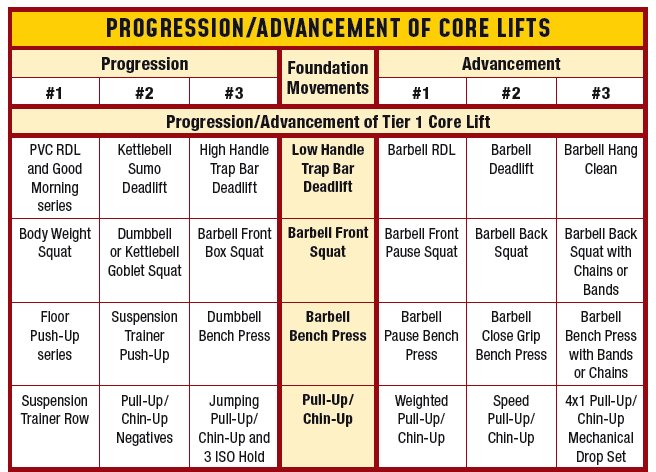Developed by strength and conditioning expert and high school coach Mike Volkmar, The High School Athlete: Football is the essential program for any student who wants to train and play football in high school. Check out Mike’s essential tips on the most important exercises to focus on first to build a great foundation for strength and development.
“Bench, squat, and deadlift!” I’ll bet that’s what your old high school coach said would make you stronger and faster. Your kid might even be telling you to the same thing. But as a parent, youth coach, and/or high school coach, you need to know that your athletes should not all be doing the same workouts. Some kids mature physically faster; some kids are taller than more most; some Juniors in high school get a late start in the weight room, while some incoming freshman get an early start. So the mantra of “Bench, squat, and deadlift” can no longer be relied on as a one-size-fits-all program.
But you still want your child and your players to get stronger. So how do you get them started, effectively and safely?
For my high school football players (and all my high school athletes), I work from what I call the “Big 4”: four essential, foundational movements that let me program a wide range of routines for a wide range of players.
They are:
Immediately, people start wondering at what’s being “left out.” What about the clean, you ask? Isn’t every high school football player supposed to clean? but the hang clean, or power clean, is a highly technical movement that can take years of consistent practice. It takes multiple qualified strength coaches working a room of 40 football players to teach the clean safely and properly. It is very difficult to learn clean movements on your own or from an online video.
The trap bar deadlift, barbell front squat, barbell bench press, and pull-up/chin-up are the four exercises I believe each and every high school football player can—and should—use to become savagely strong!
Trap Bar Deadlift
Requiring less lower back stress when compared to the traditional deadlift (due to a more vertical torso angle and the fact that your center of gravity stays inside the bar), the trap bar deadlift is a great way to quickly build confidence in younger athletes. The movement is easy to learn and allows the athlete to move some real weight; it also allows athletes who do not yet have the proper mobility for a traditional deadlift to deadlift safely.
A very important coaching point on the deadlift (which some call the hip hinge) is that it is at once the most difficult and most important movement to teach a young athlete. It is a challenging movement to coach and learn, but it can be picked up through patience, practice, and the development of core stability strength. The deadlift/hinge movement directly relates to an athlete’s speed development and power potential because it lays the proper foundation for the RDL and clean.
Barbell Front Squat
As a movement, the barbell front squat allows for more core activation and less lower back stress than the back squat. It’s great for younger, more inexperienced athletes, as less mobility is required to reach desired depths during the squat. It also promotes better posture and thoracic (mid-spine) extension for the average student-athlete who sits for 6–8 hours a day, all while teaching the catch position of the clean.
That said, I believe it’s better to learn the back squat after an athlete builds a quality front squat. Too many athletes push too much weight too early on the back squat, sacrificing depth and technique. Then, when they try the front squat, they get frustrated: they cannot do as much weight, it hurts their wrists, and so eventually they give up. This doesn’t happen when you learn to front squat first.
Barbell Bench Press
Without exception, every football player gets pumped for Bench Day. Considered the gold standard for the horizontal press, the barbell bench press is easily the best exercise for building chest, shoulders, and triceps size and strength. The biggest difference is that the barbell must be earned. I discuss in The High School Athlete: Football the many variations of push-ups and dips my own athletes must complete before getting the privilege of the bench press! Suffice to say, anything that’s as worth doing as the bench press is worth doing well.
Pull-Up/Chin-Up
The pull-up (or chin-up, depending) is a versatile movement, easy to add in between any and all bench and shoulder press sets. This is a great exercise for young, passionate student athletes, as it represents the almost primal nature of dominating your own body weight. Despite this, the pull-up is slowly disappearing from most standard physical education programs, which is a shame. It has any number of variations, allowing anyone to customize to fit their needs, and can even be used as an indicator of a player’s speed on the field. For example, non-linemen who cannot do a single chin-up are either overweight, weak, or both.
Even more than with the Bench Press, it is imperative for the Chin-Up or Pull-Up to be programmed differently for heavier positions like linemen. When pushing linemen towards body weight competency (like the ring row or pulldown machine), keep in mind the added intensity from their heavier weight.
Above is an easy-to-follow chart to help incoming freshmen build to these foundational movements, as well as an assortment of advanced exercises for those junior and senior athletes who have built a proper foundation. For more information and for advancing to next levels, pick up The High School Athlete: Football.
MICHAEL VOLKMAR, MS, CSCS, PES, CPT, received his master’s degree in Exercise Science with a specialization in Exercise, Nutrition, and Eating Behavior from George Washington University (GWU). In 2001, Mike started his well-traveled path in Sports Performance Training at the Junior College level (OCC, Onondaga, NY) working with the baseball team. He worked for three years as the Strength and Conditioning Coach at GWU, first with the Single A affiliate (High Desert Mavericks) of the Milwaukee Brewers, and later season with the Double A affiliate (Harrisburg Senators) of the Washington Nationals, before moving on to spend one year at the International Performance Institute of IMG Academies, FL. Mike continued his professional development by becoming the Director of Strength and Conditioning at the APEX Academies. Currently, Mike is the strength and conditioning coach at the Peddie School. A Division I baseball player during his undergraduate career, Mike is an amateur powerlifter with a passion for all things fitness. Mike has advanced specialty certifications in strength and conditioning, post-rehab exercise, athletic development, and sports medicine. He is the co-author of the Mobility Workout Handbook.







